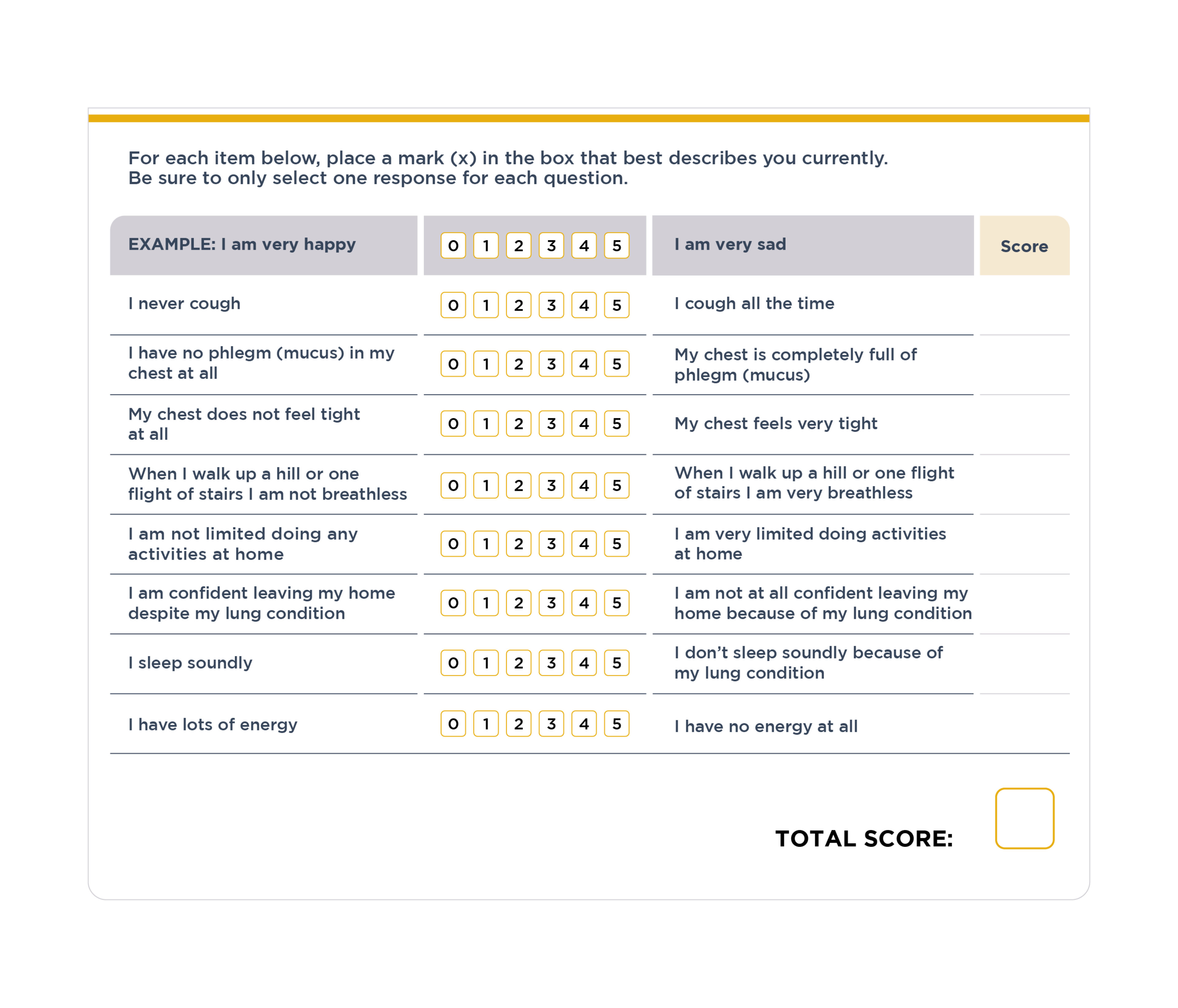- Article
- Source: Campus Sanofi
- Jun 4, 2024
Key tools to measure the success of COPD management


Learn more on how to assess these goals below
How to evaluate success in achieving treatment goals?
Success in managing chronic obstructive pulmonary disease (COPD) is multifaceted and can be measured by reduction in symptom severity and disease progression, clinically meaningful reductions in exacerbations, significant improvement in lung function, improved exercise tolerance and an increase in a patient’s quality of life (QoL). Treatment success requires a continuous cycle of assessment, treatment adjustment, and a review of response.1 Evidence-based metrics can be used to gauge outcomes in COPD patients and provide a structured way to assess the effectiveness of treatments and guide clinical decisions towards improving the lives of patients with COPD as discussed in the following sections.
What is the impact of exacerbations on patients’ disease trajectory?
Frequent exacerbations are associated with poor health status, morbidity, and mortality. They can result in a decline in lung function and frequent hospitalizations.1,2 Minimizing the negative impact of ongoing exacerbations and reducing the number and severity of exacerbations is critical to COPD management.2 Successful treatment is often reflected in fewer hospitalizations due to exacerbations and a better control of symptoms.2,3
To learn more about the impact of exacerbations, read this article The Impact of exacerbations in COPD | Campus Sanofi.
How is lung function assessed in patients with COPD?
Rapidly declining lung function in patients with COPD results in impaired health status and increases risk of mortality.4 Assessment of lung function by spirometry, particularly the Forced Expiratory Volume in 1 second (FEV1), plays an important role in determining the severity of COPD and guiding treatment.4 A slower decline in FEV1 over time is indicative of successful disease management.4
How can symptoms and their impact be assessed?
Symptoms impact the daily lives of patients by significantly influencing physical activity, health status and QoL.2 COPD treatment guidelines recommend using standardized multidimensional measures, COPD assessment test (CAT), modified Medical Research Council (mMRC) dyspnea scale and, St. George’s Respiratory Questionnaire (SGRQ), for assessing health status and QoL.1,5
Which symptoms can be scored on CAT?
CAT is simple and easy to administer and scores 8 functional parameters — cough, phlegm, chest tightness, breathlessness while climbing up a hill or flight of stairs, activity limitation at home, confidence leaving home, sleep, and energy. These 8 parameters are scored on a scale of 1 to 5, with a total score of 40.1,5 The CAT score provides a measure of the impact of disease on patient’s daily life. A CAT score of 5 is the upper limit of normal in healthy non-smoking individuals.6 A worsening CAT score in COPD patients may suggest unreported exacerbations by patients, discontinuation of medications, ineffective intake of treatment, rapid disease progression, or the need for specialist intervention.6
CAT™ Assessment1,7

What is the use of mMRC questionnaire in symptom assessment?
Dyspnea shows poor association with objective evaluation of lung function, exercise capacity, and other outcomes as it is a subjective metric.4 The mMRC questionnaire is used to assess the severity of dyspnea by grading its impact on daily activities on a scale of 0 to 4.2,8 A decrease in mMRC scores indicates successful alleviation of the symptoms.8
How does St. George’s Respiratory Questionnaire (SGRQ) help physicians assess COPD patients?
Health Status and QoL are vital outcome parameters that should be assessed in patients with COPD. Perceptions about the impact of symptoms on patient’s QoL may considerably vary between HCPs and their patients.2,9 Tools like the SGRQ, encompassing domains of symptoms, activity, and psychosocial impact, evaluate the effects of COPD on respiratory health and daily life.4,10,11 With a maximum total score of 100 points, COPD treatment guidelines recommend regular symptomatic treatment in case of SGRQ score ≥25.1,4 A lower score on SGRQ reflects improved health status. A minimum change in SGRQ score of 4 units is considered as clinically relevant.10

What other parameters should be monitored to evaluate treatment success?
According to COPD treatment guidelines, walking tests can be used to evaluate disability and risk of mortality.1 Reduced exercise capacity is associated with disease progression, increasing predisposition to poor QoL, hospitalization and mortality.1 A six-minute walk test (6MWT) can be performed to assess exercise tolerance.12 An increase in the distance covered during the 6MWT signifies enhanced physical fitness, a key goal to reduce symptoms.

References
- Global Initiative for Chronic Obstructive Lung Disease. Global strategy for the diagnosis, management, and prevention of chronic obstructive pulmonary disease (2024 report). Accessed [April 21, 2024]. https://goldcopd.org/wp-content/uploads/2024/02/GOLD-2024_v1.2-11Jan24_WMV.pdf.
- Vogelmeier CF, Roman-Rodríguez M, Singh D, et al. Goals of COPD treatment: Focus on symptoms and exacerbations. Respir Med. 2020;166:105938.
- Zhang Y, Morgan RL, Alonso-Coello P, et al. A systematic review of how patients value COPD outcomes. Eur Respir J. 2018;52(1)1800222
- Glaab T, Vogelmeier C, and Buhl R. Outcome measures in chronic obstructive pulmonary disease (COPD): strengths and limitations. Respir Res. 2010;11(1):79.
- van der Molen T, Miravitlles M, and Kocks JWH. COPD management: role of symptom assessment in routine clinical practice. Int J Chron Obstruct Pulmon Dis. 2013;8:461-71.
- COPD assessment test. User guide. Expert guidance on frequently asked question. Available at: https://www.catestonline.org/content/dam/global/catestonline/documents/CAT_HCP%20User%20Guide.pdf . Last accessed: May 27, 2024
- Jones PW, Harding G, Berry P, Wiklund I, Chen WH, Kline Leidy N. Development and first validation of the COPD Assessment Test. Eur Respir J. 2009;34(3):648-54.
- The modified MRC Scale. Available at: https://www.pcrs-uk.org/sites/default/files/resources/MRC-Score.pdf Last accessed: May 27, 2024
- Celli B, Blasi F, Gaga M, Singh D, et al. Perception of symptoms and quality of life - comparison of patients' and physicians' views in the COPD MIRROR study. Int J Chron Obstruct Pulmon Dis.2017;12:2189-2196.
- St. George’s Respiratory Questionnaire application. Available at: https://sgrq.github.io/ Last accessed: May 27, 2024
- St. George’s Respiratory Questionnaire manual. Available at: https://www.sgul.ac.uk/research/research-operations/research-administration/st-georges-respiratory-questionnaire/docs/SGRQ-Manual-March-2022.pdf Last accessed: May 27, 2024.
- What to know about the 6-minute walk test. Available at: https://www.medicalnewstoday.com/articles/6-minute-walk-test Last accessed: May 27, 2024.
MAT-GLB-2400917